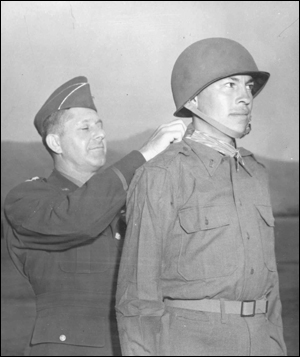
First Lieutenant Ernest Childers receives his Medal of Honor from Lieutenant General Jacobs L. Devers, at a special awards ceremony in Naples, Italy.
National Archives and Records Administration
1944Naples, Italy - Second Lieutenant Ernest Childers, Company C, 180th Infantry (OK), 45th Infantry Division (AZ, CO, NM, OK) receives his Medal of Honor from Lieutenant General Jacob L. Devers, the U.S. Army's Deputy commander for the Mediterranean Theater. Childers, a full-blood Creek Indian, joined the Oklahoma Guard in 1937, rising to the rank of first sergeant by the time the 180th landed in Sicily in July 1943. He earned a battlefield commission to second lieutenant during this campaign. He remained with his company when it landed at Anzio, Italy, on September 13th. While leading his men near Oliveto, Italy, on September 22, 1943, he earned the Medal for single-handedly capturing two machine gun nests, killing at least five enemy soldiers and then captured a German mortar observer, all with a fractured ankle! After World War II Childers remained in the Army, obtaining the rank of lieutenant colonel before his retirement in 1965. He died in 2003. He is the only Native American Guardsman to earn the nation's highest award for valor.